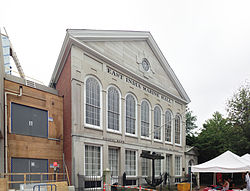This article may incorporate text from a large language model .(May 2025) |
This is a timeline of the history of the city of Salem, Massachusetts, United States.
This article may incorporate text from a large language model .(May 2025) |
This is a timeline of the history of the city of Salem, Massachusetts, United States.


































1984












{{cite web}}: |last= has generic name (help){{cite book}}: ISBN / Date incompatibility (help)Parker's move comes on the heels of its 1983 entry into children's books. Its 12 books about Care Bears and Strawberry Shortcake sold an unprecedented 3.5 [million units].
Salem, Massachusetts, is a destination recognized around the world for its rich history... Today more than one million people visit Salem annually, generating more than $100 million in tourism spending.
{{cite web}}: CS1 maint: multiple names: authors list (link) CS1 maint: numeric names: authors list (link){{cite web}}: CS1 maint: multiple names: authors list (link) CS1 maint: numeric names: authors list (link){{cite journal}}: CS1 maint: ref duplicates default (link){{cite book}}: CS1 maint: location missing publisher (link){{citation}}: CS1 maint: ref duplicates default (link) + Chronology